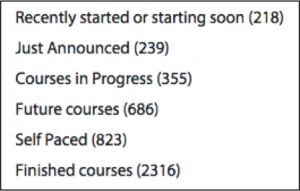One of the challenges in designing any educational program is balancing the need for individual freedom (of pace, space, relationship, technology and other freedoms that Jon Dron and I have described in Teaching Crowds) with the benefits of social learning. Maximizing freedom leads down a path of individualized and self-paced programming. It may be possible to Have your cake and eat it too, but incorporating social activities into self-paced programming presents many challenges to designers, teachers and students. In this post I want to describe promising developments in self-paced MOOCs for use in blended learning contexts
One of the advantages of blended learning and its variation of a “flipped classroom” is the mix of event based programming with student freedom to shift at least space and time during the asynchronous, online portions of the course. However, aggregating, creating and curating the content and activities for the online portions of this model can present challenges for teachers and especially those with limited levels of network literacy. The growing number of Open Educational Resources and content, not specifically designed for education, but with an open license certainly helps meet this need. I’ve often thought that MOOCs or portions of MOOCs could be ideal material for this task. They often display production quality beyond a single, underfunded teacher/producer and student exposure to well-known academic experts and good teachers can enhance the learning experience. However, two challenges have, to date, frustrated extensive use.
The first challenge relates to access. Most MOOC content and especially that produced by commercial companies is copyright protected and often hides behind passwords or is only accessible a limited number of times during a year. The second challenge also relates to scheduling in that the majority of MOOCs have been paced, meaning the start and finish dates are set by the MOOC provider and these dates rarely match with the scheduling needs of blended learning programs.
Progress is being made on both fronts. The recent “State of the Commons” report celebrates the continuing increase in amount of content licensed with a variety of Creative Commons licenses. This material can legally be included in blended learning courses. On the second front more and more MOCCS are moving to a self-paced delivery format or they are offered as self-paced resources after their debut as a paced course.
This shift is illustrated by data from Class Central, which provides a directory of MOOC offerings from many providers.
As can be seen there are 2,316 finished MOOC courses. Presumably none of the content from these courses is available for re-use. However, there is a significant and growing number of courses that are offered in self-paced format. Udacity has been delivering its mostly science orientated programming using self-pacing almost since their inception. But it is CoursEra who is demonstrating the shift towards self-paced programming most clearly. No doubt they see potential revenue (from completion certificates and revenue generating eye-balls) disappearing as soon as the course has finished.
A very limited of educational institutions (for example Athabasca and Thompson Rivers in Canada, Open University of the Netherlands and Open PolyTech in New Zealand) offered self-paced courses for years. Predictably, course completion in self-paced courses is always less than in event paced courses. However, as CoursEra and other MOOC suppliers are realizing, self-paced courses offer distinct advantages to some students. As described in my earlier post, we have attempting for years to provide “compelling, but not compulsory” learning activities that include social learning opportunities for our self-paced students at Athabasca. These effort have not been overly successful and integration within the administrative structure of self-paced institutions remains challenging. (see for example the challenges uncovered by one of my Doctoral Students, Jan Thiessen in her thesis Self-Paced study at a Distance.
Nonetheless, the much larger context of blended learning, may more easily incorporate self-paced resources in their blended programing. A number of studies have looked at MOOC use in flipped or blended classrooms – (Bruff, Fisher, McEwen, & Smith, 2013; Holotescu, Grosseck, Cretu, & Naaji, 2014; Milligan, Littlejohn, & Margaryan, 2013). Generally they conclude that the social glue from the classroom does a nice job of pacing and providing social interactions between and among students and instructors. Yousef, Chatti, Ahmad, Schroeder, & Wosnitza (2015) also do a nice job of showing how learning analytics can also be used by students to monitor the course and their performance.
Thus, I think self-paced MOOCs will continue to find a valuable role in the ongoing (if SLOW!) evolution of Universities and adult education and learning generally. The classroom experience can motivate and pace while providing an instructor the opportunity to personalize, regionalize or in other ways add value to the MOOC. And finally, let’s never forget the potential of this type of blended intervention to save instructor time.
References
Bruff, D. O., Fisher, D. H., McEwen, K. E., & Smith, B. E. (2013). Wrapping a MOOC: Student perceptions of an experiment in blended learning. MERLOT Journal of Online Learning and Teaching, 9(2), 187-199.
Holotescu, C., Grosseck, G., Cretu, V., & Naaji, A. (2014). Integrating MOOCs in Blended Courses. Paper presented at the The International Scientific Conference eLearning and Software for Education.
Milligan, C., Littlejohn, A., & Margaryan, A. (2013). Patterns of engagement in connectivist MOOCs. MERLOT Journal of Online Learning and Teaching, 9(2).
Yousef, A. M. F., Chatti, M. A., Ahmad, I., Schroeder, U., & Wosnitza, M. (2015). An Evaluation of Learning Analytics in a Blended MOOC Environment. The European MOOC Stakeholder Summit.

I am glad i got to read THIS. I have been examining out a few of your articles and its pretty stuff to read. I will surely bookmark your blog.